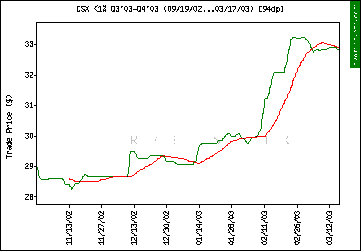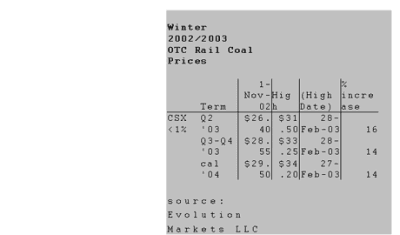Get Your Hedge On: 2002-2003 Winter Provides Glimpses of Coal Hedging Strategies
<a href=www.energypulse.net>Energy Pulse article 4.28.03 Joseph Cacioppo, Director, Coal Services for Evolution Markets, Evolution Markets LLC
A sharp rise in demand due to a cold and snowy winter in the Northeast, a disruption in coal imports, credit problems, and rising energy prices converged this winter to push near term coal prices upward. Producers, end users, and markets should take heed. The volatility in over-the-counter (OTC) coal markets highlighted the price risk faced by market participants. Companies that hedged this risk prior to winter softened the blow from a run up in prices. Recent OTC market activity illustrates the benefits of instituting hedging strategies, whether you are a producer, end user, trader, or marketer.
Big Chill, NS Supply Crunch Converge
The big chill started it off. This winter was considerably colder in the Northeast than in recent years. In addition, unusual amounts of snowfalls blanketed the region. The vagaries of Mother Nature contributed to an increase in power demand from November to mid-March. During that time burns were up and coal stockpiles were down.
Credit issues for utilities impacted their willingness to tie up cash with coal purchases to refurbish their stockpiles. Rather than pile up cash at their plants, utilities conserved funds. At the same time utilities were not fully hedged against price movements for when they really need to return to market. Market watchers feel there will be a flurry of activity to replenish supplies, especially in the second half of this year.
Further complicating matters was a supply crunch from producers serving Northeastern power producers. There was a virtual shutdown in production from Venezuela. First a general labor strike shuttered mines. Later, even as coal miners prepared to go back to work, a continued strike in the oil sector inhibited coal producers ability to ramp up operations to meet export demand. Venezuelan mines went back online in February, but the incident highlighted the political risks involved with taking coal out of the region. Much of the coal from Venezuela bound for the U.S. was a 1.2#, high-BTU coal very near compliance specs for American power producers.

Those caught short during the shutdown turned to regional compliance coal supplies on the NS. Unfortunately, NS coal took a blow in supply at about the same time imports dried up. A major supplier in the region, Horizon Energy entered into bankruptcy – severely restricting supply for coal buyers on the eastern seaboard. Horizon’s demise compounded the Venezuelan problem, leaving the east coast with tight supplies of compliance coal during an unusually cold winter.
Perhaps the best representation of the impact of eastern coal shortfalls is the in the spread between the CSX and NS coals. In past years, the NS compliance coal has traded at a premium to CSX, but the difference was always between $0.10 and $0.25 per ton. Lately, the spread has widened significantly to between $0.50 and $1.00 per ton.

These demand and supply factors alone can account for the run up in coal prices for 2003, but there another – more esoteric –- factor impacted the market. The increase in coal prices coincided with the general rise in energy prices from heating oil and petroleum to natural gas and power. The correlation between the price of coal and other domestic energy commodities is subject to perennial debate in the industry. Some argue that coal production is constant and coal plants are mainly baseload generation and therefore not subject to dispatch based on natural gas or oil prices.
True, but the rise in coal prices over the last five months closely mirrors the NYMEX natural gas price curve. Mark it up to perception over reality that creates a psychological – if not entirely real – connection. Many of the largest volume traders in coal are also active traders in other energy commodities. Speculation plays are likely being made across the board for energy commodities, ultimately moving coal in OTC markets.

Numbers Tell the Story
And, the moves in OTC markets over the winter have been significant. Prices in CSX <1% coals were particularly indicative of the upward trend in coal prices. At the onset of this winter season, CSX coal delivered in the second quarter of 2003 was trading for $26.40, but near the end of the first quarter of this year it was trading for $31.50 – a 16 percent increase. The outer delivery dates were equally impacted. CSX coal for the back half of 2003 rose to $33.25 from $28.25 from November 2002 to the tail end of March 2003. This represents a 14 percent increase, which is also reflected in coal being sold in the spot market for the next calendar year.
Physical Hedging Protects Bottom Line
The recent volatility in OTC coal markets points to the changing relationship of producers and end users. Both are now adept at using the OTC market to hedge price risk and manage inventories. Some are getting smarter at looking at buying and selling coal as a hedge game that can protect the bottom line from major price swings like we’ve experienced this winter.
Hedging, at its most basic, is an offset of a natural position. Both producers and end users – as well as traders and marketers – can take simple steps to hedge price risk in increasingly volatile OTC coal market.
Producers Maximize Profits
Even as prices rise, coal producers face the risk that they will enter into contracts at prices that will ultimately be below market or that they will be caught short on supply contracts and forced to turn to the market and pay dearly to meet supply obligations. Both scenarios can be easily hedged in OTC markets.
For instance, a producer could have gone to the OTC market last fall and purchased several trains of rail coal, such as CSX <1%, for the second quarter of 2003 at $26 a ton. If the price did not change, the producer could have applied the OTC purchased coal to a contract with one of its utility customers – leaving coal in the ground for future sales.
But, the price went up and eventually hit more than $33 a ton for Q2 ’03 CSX <1%. The producer could, as above, apply the OTC coal toward its supply obligation. Or, it could take advantage of the market’s upward swing by selling the OTC coal into the market – taking a $7/ton profit – and sell its own coal at the elevated price.
End Users Play Time Spreads
Price spikes can be particularly painful for end users who may have to cover short inventories or have an unusual spike in demand. But they, too, can use OTC coal markets to hedge their price risk – and do so while being sensitive to cash concerns.
An end user that may be slightly short coal during a price upswing, can execute a ‘time spread’ hedge in the OTC market in order to soften the blow of purchasing coal at its peak. By purchasing ‘outer coal’, or coal in the latter quarters of a calendar year, it can play off the difference price spreads.
For example, an end user that may be short coal in Q2 ’03 can turn to the OTC market to meet these supply needs – while also buying Q3-Q4 ’03 coal in the OTC markets as a hedge. As Q2 coals rallied in price, this should also drag up the back part of the forward price curve. The end user can later sell the coal purchased in the back half at a profit and use these proceeds to flatten out the balance sheet already in the red from increased short-term coal prices.
Derivatives an Option, Too
The examples above are simple hedges that can be made in the physical OTC coal market. There are, of course, financial hedges or derivatives that can also have the same benefit of protecting against major price swings.
Options plays can protect buyers and sellers against just the type of price risk we have outlined here. Producers looking to take full advantage of price upswings can buy call options that provide them the right but not the obligation to buy coal at a price that may be below the market rate in the future. If the price of coal goes above the option strike price, the producer can exercise the option and then sell the coal at the prevailing market – taking a profit.
Options also provide end users particularly good hedge opportunities. An end user can protect against upward swings in the market by purchasing a similar call option, but this time locking in a price that may be less than the market price in the future.
With many market players, especially utilities and producers, increasingly taking efforts to conserve cash, the options market remains relatively dormant. Nonetheless, market players continue to turn to the OTC market for physical hedges, and there are counterparties available to gain similar results in financial derivative products.
Readers Comments 4.28.03 william grebenc "well written concise, nice snapshot on using traded mrkt to manage risk"